As it turned out, the drive was quick, so we had time for a leisurely breakfast of tasty muffins and coffee in Cambria. Then we drove up to the Hearst Castle and began our tour.
Going into the tour, we didn’t know what to expect. Our best guess was that it was probably overpriced and silly, but it seemed to be a must-see for travelers in the area, so we decided to do it anyway – sort of like Graceland. As it turns out, we were wrong – it was fascinating. The castle and grounds are amazing as both architectural achievement and antiquities museum. But most interesting was the story of Hearst himself, which unfolded throughout the tour.
William Randolph Hearst was a child of privilege, the son of George Hearst, a gifted or lucky prospector who was a major investor in the Comstock Lode, one of the U.S.’s biggest silver discoveries. George Hearst acquired 100,000 acres or so in the San Simeon area of California, and the family used it for ranching and camping.
Then William Randolph Hearst came along. Hearst worked on the Harvard Lampoon and then found out that his father had acquired The San Francisco Examiner newspaper as payment of a gambling debt, so he asked his father to let him run the paper. He was later expelled from Harvard and could focus full-time on the paper. As publisher, he increased readership dramatically and then set his sights on higher goals. He acquired a New York newspaper, moved to New York City, and embarked on a bitter circulation war with Joseph Pulitzer, who ran the leading New York paper. Hearst won the war, and continued building his newspaper empire, ultimately running upwards of 30 papers.
Newspapers were his livelihood, but collecting was his hobby. At age 10, he and his mother took a long trip to Europe, which sparked his love for art and architecture. For the rest of his life, he would acquire traditional sculptures and other pieces of art and well as less traditional items like doors from cathedrals. His collection filled warehouses.
By the 1920s, he was around 60 years old, and he began to build on the San Simeon property, where he had camped as a child. He partnered with Julia Morgan, an architect, to turn his vision into a reality. Initially, he wanted 25 rooms, but he and Morgan continued building for decades, adding on extension after extension, and what’s there today is a still-unfinished 125-room, 73,000-square-foot castle. That’s just the central building – it’s also surrounded by three guesthouses, an outdoor pool, and gorgeously landscaped grounds. The visitors center contains copies of some of the correspondence between Hearst and Morgan. It reminded us of email communications at Microsoft – the high-level manager (Hearst) sends a cryptic, ten-word suggestion in sentence fragments, which the rank and file (Morgan) scrutinize for hours, eventually crafting a carefully worded multipage reply fleshing out the idea, analyzing pros and cons, suggesting alternatives, etc.
Much of Hearst’s art and artifact collection was transported to San Simeon, where pieces were incorporated into the castle. Antiquities were modified and new pieces were commissioned to fit the overall vision so that the resulting castle is a wonderful combination of old and new into something entirely original.
The tour started with a bus ride up to the top of a hill. On the bus ride, we were supposed to look out for zebras. Hearst had all sorts of animals on the grounds – kangaroos, a polar bear, and more – but most of those are gone now, given away late in Hearst’s life to zoos and private owners who would take good care of them. But descendants of Hearst’s zebras remain, although we didn’t see any.
The location of the castle is beautiful, with amazing ocean views.
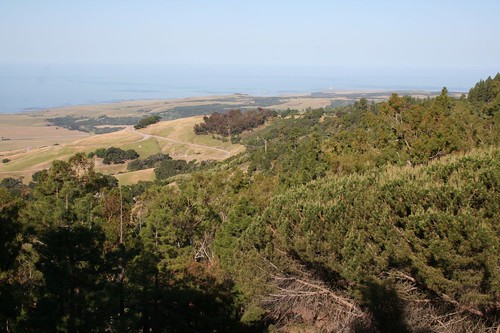
The first major sight on the tour is the Neptune Pool. Apparently, Hearst and Morgan built it several times and then rebuilt it until Hearst was satisfied.
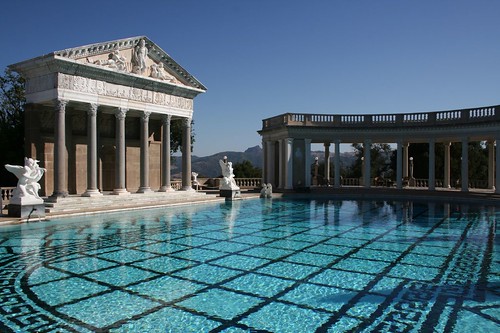
The six columns fronting the Parthenon-like building are ancient, while many of the statues were new. We got several other good views as the tour continued.
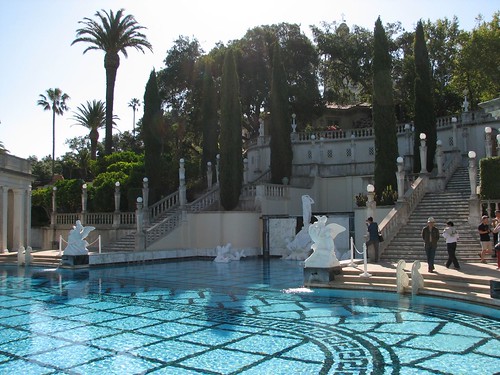

The grounds were beautifully landscaped.
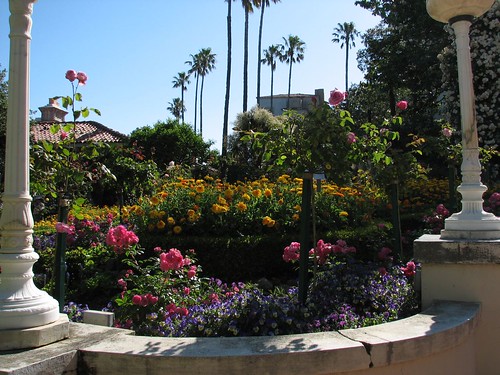

Greek-looking (but actually contemporary) nude sculptures a common part of the landscaping.

The tour continued into one of the guesthouses. For a couple of decades, Hearst ran his newspaper empire from the castle while entertaining guests daily. He invited dozens of interesting people, including many celebrities, to stay at the “ranch,” as he called it. He would work during the day while the guests could explore the grounds, swim, go horseback riding, etc. In the evening, the guests would join him for cocktails, dinner, and stimulating conversation. By all accounts, Hearst wasn’t an especially outgoing man, and that’s probably partly why his bid for President of the U.S. was unsuccessful. But he apparently enjoyed hosting interesting people at his house.
The rooms in the guesthouse were elaborately furnished.

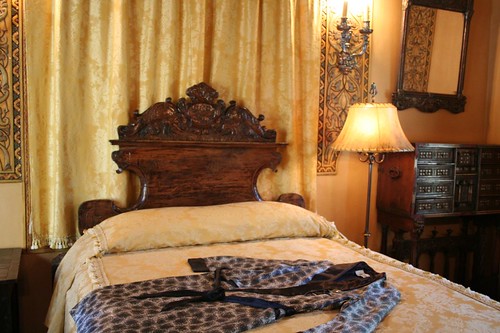
Back outside, we passed an ancient Egyptian sculpture, the oldest at the Hearst Castle.
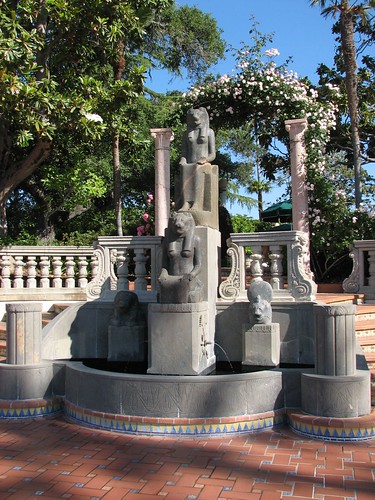
Shortly before we entered the main castle, we were treated to more spectacular views.
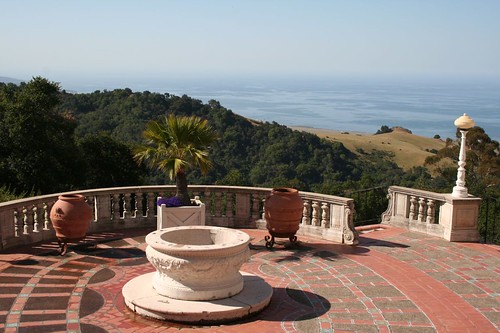
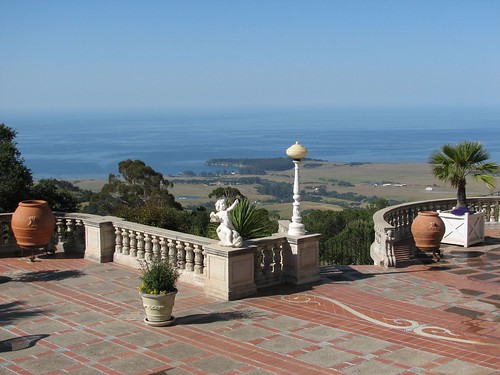
The exterior castle itself was fashioned like a cathedral. However, for earthquake-proofing, a special skill of Julia Morgan’s, it was built of steel-reinforced concrete, with sheets of limestone on the outside scored to make it look like brickwork.
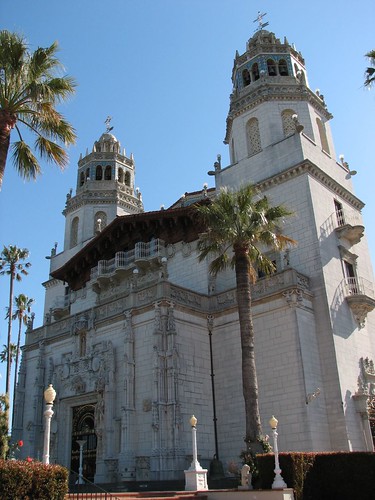

The dining room contained a long table with colorful flags above.
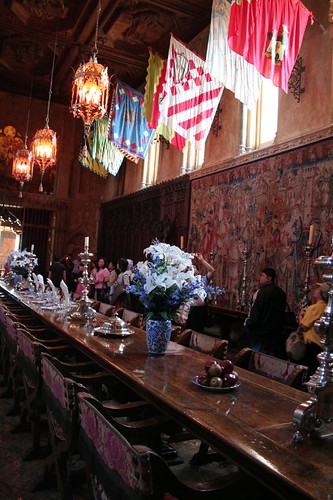
Although Hearst appreciated finer things, he apparently wasn’t especially stuffy or prone to excessive formality, as shown by the bottles of mustard and ketchup that appeared at dinner.
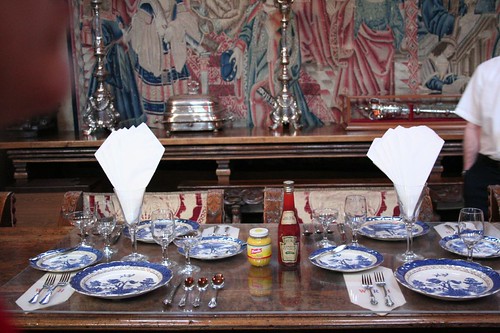
The tour ended with an indoor pool that was covered in lovely blue tile and gold leaf, with a diving platform above.
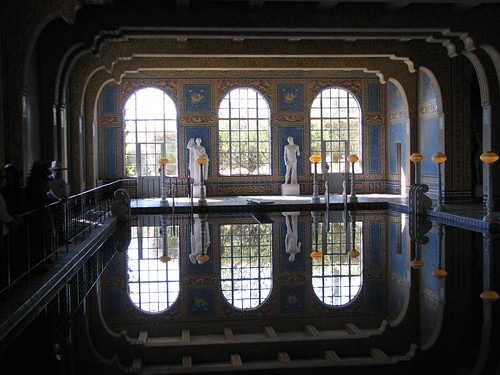
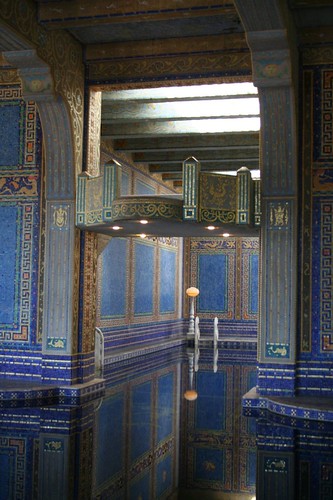
After the tour, we spent a long time in the visitors center, watching a movie about Hearst’s life and the construction of the castle, as well as exploring the exhibits. We hadn’t expected much, but four hours after we arrived, we had to drag ourselves away because we knew finding a campsite on Big Sur for the weekend might be difficult. Good bye, Hearst Castle!
No comments:
Post a Comment